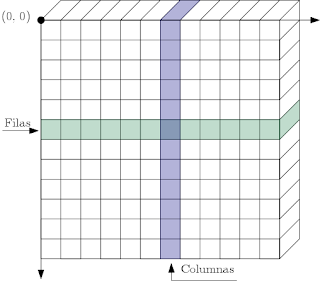Con gusto bro, cualquier duda no dudes en preguntar.
Saludos.
Saludos.
Esta sección te permite ver todos los mensajes escritos por este usuario. Ten en cuenta que sólo puedes ver los mensajes escritos en zonas a las que tienes acceso en este momento.
Mostrar Mensajes Menú

>>> import numpy as np
>>> x = np.array([1, 2, 3]) # Vector
>>> x
array([1, 2, 3])
>>> X = np.array([[1, 2, 3], [4, 5, 6]]) # Matriz 2x3
>>> X
array([[1, 2, 3],
[4, 5, 6]])>>> import numpy as np
>>> identidad = np.identity(3)
>>> identidad
array([[ 1., 0., 0.],
[ 0., 1., 0.],
[ 0., 0., 1.]])
>>> ceros = np.zeros((3, 3))
>>> ceros
array([[ 0., 0., 0.],
[ 0., 0., 0.],
[ 0., 0., 0.]])
>>> unos = np.ones((3, 3))
>>> unos
array([[ 1., 1., 1.],
[ 1., 1., 1.],
[ 1., 1., 1.]])>>> import numpy as np
>>> a = np.ones((3, 3)) # Crea una matriz de unos 3x3
>>> a
array([[ 1., 1., 1.],
[ 1., 1., 1.],
[ 1., 1., 1.]])
>>> a = a * 2 # Multiplica cada componente de a por 2
>>> a
array([[ 2., 2., 2.],
[ 2., 2., 2.],
[ 2., 2., 2.]])
>>> b = np.ones((3, 3)) ** 5 # Eleva cada componente a la quintapotencia
>>> b
array([[ 1., 1., 1.],
[ 1., 1., 1.],
[ 1., 1., 1.]])
>>> b = b + 5 # Suma a cada componente de b 5
>>> b
array([[ 6., 6., 6.],
[ 6., 6., 6.],
[ 6., 6., 6.]])
>>> a @ b # Multiplicación matricial entre a y b
array([[ 36., 36., 36.],
[ 36., 36., 36.],
[ 36., 36., 36.]])
>>> b > 5 # Componentes mayores que 5
array([[ True, True, True],
[ True, True, True],
[ True, True, True]], dtype=bool)
>>> b < 3 # Componentes menores que 3
array([[False, False, False],
[False, False, False],
[False, False, False]], dtype=bool)
>>> >>> import numpy as np
>>> x = np.array([1, 2, 3])
>>> x[0]
1
>>> x[1]
2
>>> x[-1]
3
>>> >>> import numpy as np
>>> a = np.identity(3)
>>> a
array([[ 1., 0., 0.],
[ 0., 1., 0.],
[ 0., 0., 1.]])
>>> a[1, 1]
1.0
>>> a[1,-1]
0.0
>>> a[0,0]
1.0
>>> import numpy as np
>>> x = np.arange(10)
>>> x
array([0, 1, 2, 3, 4, 5, 6, 7, 8, 9])
>>> x[:5]
array([0, 1, 2, 3, 4])
>>> x[5:]
array([5, 6, 7, 8, 9])
>>> x[-1:0:-1]
array([9, 8, 7, 6, 5, 4, 3, 2, 1])
>>> x[-1:0:-2]
array([9, 7, 5, 3, 1])>>> import numpy as np
>>> a = np.identity(3)
>>> a
array([[ 1., 0., 0.],
[ 0., 1., 0.],
[ 0., 0., 1.]])
>>> a[1:, 1:]
array([[ 1., 0.],
[ 0., 1.]])
>>> a[:1, :1]
array([[ 1.]])
>>> a[:2, :2]
array([[ 1., 0.],
[ 0., 1.]])
>>> >>> import numpy as np
>>> a = np.identity(3)
>>> a
array([[ 1., 0., 0.],
[ 0., 1., 0.],
[ 0., 0., 1.]])
>>> a[1, 1] = 10
>>> a
array([[ 1., 0., 0.],
[ 0., 10., 0.],
[ 0., 0., 1.]])
>>> a[1:, 1:] = np.ones((3, 3))
Traceback (most recent call last):
File "", line 1, in
ValueError: could not broadcast input array from shape (3,3) into shape (2,2)
>>> a[1:, 1:] = np.ones((2, 2))
>>> a
array([[ 1., 0., 0.],
[ 0., 1., 1.],
[ 0., 1., 1.]])>>> x = np.arange(25) # Crea un vector
>>> X = x.reshape(5, 5) # Convierte el vector a matriz de 5x5
>>> X
array([[ 0, 1, 2, 3, 4],
[ 5, 6, 7, 8, 9],
[10, 11, 12, 13, 14],
[15, 16, 17, 18, 19],
[20, 21, 22, 23, 24]])
>>> mascara = (X % 2 == 0) # Genera máscara posición de los elementos pares
>>> mascara
array([[ True, False, True, False, True],
[False, True, False, True, False],
[ True, False, True, False, True],
[False, True, False, True, False],
[ True, False, True, False, True]], dtype=bool)
>>> X[mascara] = 0 # Cambia todos los pares por cero
>>> X
array([[ 0, 1, 0, 3, 0],
[ 5, 0, 7, 0, 9],
[ 0, 11, 0, 13, 0],
[15, 0, 17, 0, 19],
[ 0, 21, 0, 23, 0]])import numpy as np
def funcion(matriz):
matriz[1, 1] = 10
mi_matriz = np.ones((3, 3))
print("Antes de llamar la función:")
print(mi_matriz)
funcion(mi_matriz)
print("Después de llamar la función:")
print(mi_matriz)CitarAntes de llamar la función:
[[ 1. 1. 1.]
[ 1. 1. 1.]
[ 1. 1. 1.]]
Después de llamar la función:
[[ 1. 1. 1.]
[ 1. 10. 1.]
[ 1. 1. 1.]]
import numpy as np
def funcion(matriz):
matriz[1, 1] = 10
mi_matriz = np.ones((3, 3))
print("Antes de llamar la función:")
print(mi_matriz)
funcion(mi_matriz.copy())
print("Después de llamar la función:")
print(mi_matriz)CitarAntes de llamar la función:
[[ 1. 1. 1.]
[ 1. 1. 1.]
[ 1. 1. 1.]]
Después de llamar la función:
[[ 1. 1. 1.]
[ 1. 1. 1.]
[ 1. 1. 1.]]
columna_uno = ["hola", "soy", "Once"]
columna_dos = ["Esta", "es", "una"]
max_columna_uno = max(map(len, columna_uno))
max_columna_dos = max(map(len, columna_dos))
for e1, e2 in zip(columna_uno, columna_dos):
print("|{0}|{1}|".format(e1.ljust(max_columna_uno + 1), e2.ljust(max_columna_dos + 1)))